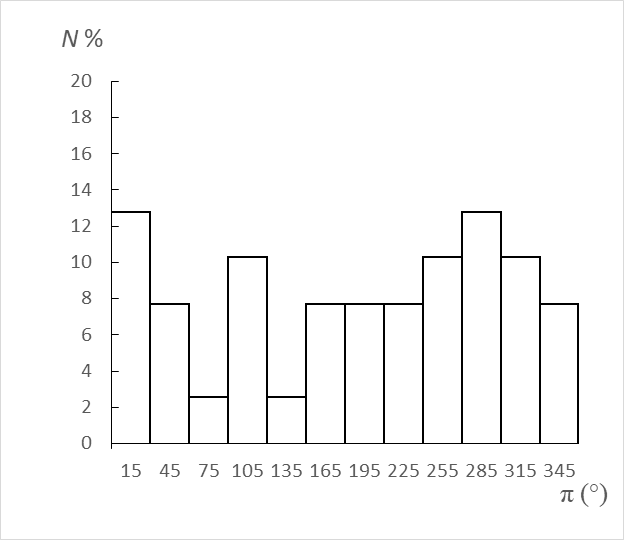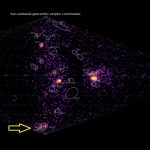By Alexandra Terentjeva and Elena Bakanas
Abstract: A group of 39 Eccentrid asteroids (e ≥ 0.4) belonging to the Mars family has been identified. Of the 670 orbits of meteoroid streams in several catalogues, only one Librid meteoroid stream, No. 50, has been found (Terentjeva, 1966), which also belongs to the Eccentrids of the Mars family. Among the 39 asteroids, 15 groupings have been discovered, comprising 33 asteroids, i.e. 84.6% of the asteroids in the system of the Eccentrids of the Mars family represent ‘organized’ matter. The distribution of asteroids by longitude of perihelion has been studied, and some features of this unique system of bodies are discussed.
Accepted for publication 15 November 2025 (Read pdf version).
1 Introduction
The Eccentrids as a system of meteoroid bodies were discovered by A. K. Terentjeva (Galibina and Terentjeva, 1981), although she had recorded meteoroid streams of the Eccentrids much earlier, in 1967–1968, when identifying minor meteor streams (Terentjeva, 1967). In our work (Terentjeva and Barabanov, 2016), we define the Eccentrids as a special group of meteoroid bodies, the orbits of which fall within the limits of a < 1 AU, e ≥ 0.4, Q ≤ 1.1 AU. In this work, 52 asteroids were found among 11673 near-Earth objects (NEOs), and some features of this system of bodies were studied. Eight asteroid streams of the Eccentrids were found. Together with the Eccentrid meteoroid system, the Eccentrid asteroid system forms a single population of minor bodies of the Solar System.
But are there in fact Eccentrids of the Mars family, i.e. minor bodies with orbits of high eccentricity belonging to the Mars family? This is the question we set in this work.
2 Research results
The work of M. Bielicki (1972) provides the limit values of the perturbation region for the planets of the Solar System. The limiting distances for planetary families (AU):
- Mercury 0.002
- Venus 0.010
- Earth 0.014
- Mars 0.010
- Jupiter 0.50
- Saturn 0.62
- Uranus 0.67
- Neptune 1.11
- Pluto 0.55
These data show that the radius of the sphere of influence of Mars on the perturbed body is very small. Our selection criteria for the orbits of the Eccentrids of the Mars family were: e ≥ 0.4 and 1.51 ≤ Q ≤ 1.53 AU. From the NASA JPL catalogue, which contained 1448137 asteroids as of 11 May 2025, 39 asteroid orbits of the Eccentrids of the Mars family were selected (Table 1).
Table 1 – The Eccentrid asteroids of the Mars family. Equinox J2000.0. Н is the absolute magnitude of the asteroid, D is the diameter of the asteroid.
| No | Full name | Epoch | a (AU) |
e | q
(AU) |
Q
(AU) |
Ω (◦) |
ω (◦) |
i (◦) |
π (◦) |
H | D
km |
Period years |
| 1 | 2021 UA1 | 05/05/2025 | 1.086 | 0.405 | 0.646 | 1.525 | 125.93 | 163.25 | 0.01 | 289.18 | 31.84 | — | 1.131 |
| 2 | 2016 CD31 | 05/05/2025 | 1.044 | 0.454 | 0.570 | 1.519 | 240.49 | 12.71 | 0.46 | 253.20 | 26.90 | 1.067 | |
| 3 | 2008 JC | 05/05/2025 | 1.045 | 0.463 | 0.561 | 1.529 | 47.86 | 58.17 | 2.50 | 106.03 | 26.50 | 1.069 | |
| 4 | 2013 SL20 | 05/05/2025 | 1.080 | 0.403 | 0.645 | 1.516 | 8.49 | 115.65 | 4.29 | 124.14 | 24.62 | 1.123 | |
| 5 | 2013 AH76 | 01/17/2013 | 0.985 | 0.547 | 0.447 | 1.523 | 347.19 | 353.77 | 4.55 | 340.96 | 22.88 | 0.978 | |
| 6 | 2014 JN2 | 05/03/2014 | 0.894 | 0.692 | 0.276 | 1.512 | 219.84 | 148.81 | 6.32 | 8.64 | 24.27 | 0.845 | |
| 7 | 2002 JD9 | 05/05/2025 | 1.056 | 0.440 | 0.591 | 1.521 | 208.16 | 139.08 | 6.61 | 347.24 | 23.20 | 1.085 | |
| 8 | 2018 VD | 05/05/2025 | 1.068 | 0.419 | 0.620 | 1.516 | 38.78 | 252.38 | 7.61 | 291.17 | 27.10 | 1.103 | |
| 9 | 2022 DY1 | 05/05/2025 | 1.050 | 0.448 | 0.579 | 1.520 | 156.05 | 249.83 | 7.85 | 45.89 | 27.92 | — | 1.076 |
| 10 | 2018 BB5 | 05/05/2025 | 0.956 | 0.593 | 0.389 | 1.523 | 128.84 | 136.24 | 7.96 | 265.08 | 24.40 | 0.935 | |
| 11 | 2018 KL2 | 05/05/2025 | 1.051 | 0.437 | 0.591 | 1.510 | 212.55 | 170.89 | 8.66 | 23.44 | 21.70 | 1.077 | |
| 12 | 2019 EO | 05/05/2025 | 0.994 | 0.532 | 0.465 | 1.523 | 130.26 | 255.55 | 9.35 | 25.80 | 23.18 | 0.991 | |
| 13 | 2010 LJ61 | 05/05/2025 | 1.046 | 0.460 | 0.565 | 1.526 | 70.83 | 48.35 | 9.80 | 119.18 | 20.95 | 0.192 | 1.069 |
| 14 | 2021 VP6 | 05/05/2025 | 1.030 | 0.483 | 0.533 | 1.527 | 16.55 | 181.06 | 10.28 | 197.61 | 21.57 | — | 1.045 |
| 15 | 4034 Vishnu 1986 PA |
05/05/2025 | 1.059 | 0.444 | 0.589 | 1.530 | 157.87 | 296.69 | 11.17 | 94.56 | 18.48 | 0.420 | 1.090 |
| 16 | 2021 TJ57 | 05/05/2025 | 1.008 | 0.507 | 0.497 | 1.519 | 4.68 | 180.12 | 11.63 | 184.80 | 21.46 | — | 1.012 |
| 17 | 2007 US | 05/05/2025 | 0.962 | 0.583 | 0.402 | 1.523 | 24.02 | 203.06 | 12.40 | 227.08 | 22.74 | 0.944 | |
| 18 | 516155 2016 DP |
05/05/2025 | 1.022 | 0.477 | 0.535 | 1.510 | 54.36 | 254.00 | 13.33 | 308.36 | 20.11 | 1.034 | |
| 19 | 152742 1998 XE12 |
05/05/2025 | 0.878 | 0.739 | 0.229 | 1.527 | 280.02 | 353.16 | 13.44 | 273.18 | 19.10 | 0.413 | 0.823 |
| 20 | 512234 2015 VO66 |
05/05/2025 | 0.952 | 0.600 | 0.381 | 1.523 | 64.46 | 219.31 | 14.02 | 283.77 | 20.62 | 0.929 | |
| 21 | 2016 GG216 | 05/05/2025 | 1.008 | 0.515 | 0.489 | 1.528 | 171.94 | 157.16 | 14.71 | 329.10 | 23.15 | 1.013 | |
| 22 | 2019 SM2 | 09/21/2019 | 0.980 | 0.550 | 0.440 | 1.519 | 174.65 | 51.02 | 15.08 | 225.67 | 26.10 | — | 0.969 |
| 23 | 2020 KK5 | 05/05/2025 | 0.932 | 0.634 | 0.341 | 1.523 | 83.25 | 325.07 | 15.15 | 48.32 | 21.93 | — | 0.900 |
| 24 | 88213 2001 AF2 |
05/05/2025 | 0.954 | 0.595 | 0.386 | 1.522 | 114.25 | 194.99 | 17.81 | 309.24 | 19.48 | 0.912 | 0.932 |
| 25 | 2014 MS67 | 05/05/2025 | 1.021 | 0.496 | 0.514 | 1.527 | 253.71 | 217.37 | 18.80 | 111.07 | 21.20 | 1.031 | |
| 26 | 481127 2005 UJ6 |
05/05/2025 | 1.068 | 0.416 | 0.624 | 1.513 | 42.36 | 131.41 | 19.00 | 173.77 | 21.50 | 1.104 | |
| 27 | 2025 DU2 | 05/05/2025 | 1.043 | 0.452 | 0.572 | 1.514 | 345.23 | 291.59 | 19.07 | 276.82 | 24.25 | — | 1.065 |
| 28 | 2022 FV | 05/05/2025 | 1.062 | 0.428 | 0.607 | 1.516 | 3.90 | 300.62 | 19.34 | 304.53 | 24.15 | — | 1.094 |
| 29 | 3753 Cruithne 1986 TO | 05/05/2025 | 0.998 | 0.515 | 0.484 | 1.511 | 126.19 | 43.88 | 19.80 | 170.07 | 15.44 | 2.071 | 0.997 |
| 30 | 234341 2001 FZ57 |
05/05/2025 | 0.944 | 0.604 | 0.374 | 1.515 | 22.09 | 339.98 | 20.67 | 2.07 | 18.93 | 0.344 | 0.918 |
| 31 | 2012 VN6 | 05/05/2025 | 1.043 | 0.461 | 0.563 | 1.524 | 216.94 | 26.24 | 21.03 | 243.19 | 21.38 | 1.065 | |
| 32 | 141531 2002 GB |
05/05/2025 | 0.992 | 0.529 | 0.467 | 1.517 | 40.81 | 8.32 | 22.55 | 49.13 | 19.15 | 0.303 | 0.988 |
| 33 | 2008 LC2 | 06/03/2008 | 1.012 | 0.499 | 0.507 | 1.518 | 78.92 | 303.73 | 23.65 | 22.65 | 24.25 | 1.018 | |
| 34 | 2011 FP29 | 04/01/2011 | 1.055 | 0.447 | 0.584 | 1.526 | 9.08 | 332.76 | 24.79 | 341.84 | 21.95 | 1.083 | |
| 35 | 2016 VU2 | 05/05/2025 | 0.987 | 0.548 | 0.446 | 1.527 | 235.37 | 18.54 | 26.79 | 253.91 | 22.00 | 0.980 | |
| 36 | 2020 UF3 | 05/05/2025 | 0.967 | 0.574 | 0.412 | 1.522 | 29.65 | 127.45 | 27.49 | 157.09 | 28.38 | — | 0.951 |
| 37 | 2015 KB57 | 05/05/2025 | 0.945 | 0.607 | 0.371 | 1.518 | 239.61 | 208.83 | 29.67 | 88.44 | 22.30 | 0.918 | |
| 38 | 250458 2004 BO41 |
05/05/2025 | 1.019 | 0.493 | 0.517 | 1.521 | 337.74 | 254.46 | 35.55 | 232.19 | 18.00 | 0.630 | 1.028 |
| 39 | 2023 VT10 | 11/16/2023 | 0.903 | 0.694 | 0.277 | 1.529 | 232.52 | 326.71 | 39.27 | 199.23 | 22.21 | — | 0.858 |
Table 2 – Orbital elements and other parameters of the Librid meteoroid stream (J1950.0)1. The source for both is No 50 in Terentjeva (1966).
| Date (UT) | αg (°) |
δg (°) |
v∞ km/s |
a AU |
e | q AU |
Q AU |
ω (°) |
Ω (°) |
i (°) |
π (°) |
| 1954 IV 7.30 | 206 | –11 | 18.8 | 1.04 | 0.48 | 0.55 | 1.5 | 294 | 17 | 0 | 311 |
| 1953 IV 11.40 | 212 | –10 | 18.1 | 1.02 | 0.46 | 0.55 | 1.5 | 296 | 21 | 2 | 317 |
(1) Over 50 years, the difference due to precession is less than 1°, which is not significant.
Now let us consider meteoroid streams. We reviewed the most significant known catalogues of orbits of meteoroid and fireball streams (Cook, Lindblad, Terentjeva, Halliday et al., Rudawska, Jenniskens), totalling 670 orbits of streams. It turned out that among them there is only one meteoroid stream of the Librids, No. 50 from the catalogue by A. Terentjeva (1966), which meets the selected criteria and is an Eccentrid of the Mars family. The elements of its orbit and other parameters are given in Table 2. Thus, the Eccentrids of the Mars family constitute 0.0027% of asteroids and 0.15% of meteoroid streams, i.e. two orders of magnitude more.
Let us analyze the data for 39 asteroids of the Eccentrids of the Mars family (Table 1). Of the 39 asteroids, 8 asteroids, i.e. 20%, enter at perihelion inside the orbit of Mercury. These are asteroids with absolute magnitudes of 19–24 and diameters ranging from 344 m to 912 m (according to three estimates). The remaining 31 asteroids out of 39 enter at perihelion inside the orbit of Venus. These data indicate the role of these planets in gravitational influence. Let us consider the distribution of 39 asteroids by longitude of perihelion, π (Figure 1). Two maxima are clearly visible in the intervals 0° < π < 30° and 270° < π < 300° (12.8% of asteroids in each). It is also worth noting a slightly smaller third maximum (10.3% of asteroids) in the interval 90° < π < 120°, on either side of which there is a deficit of longitudes of perihelion in the intervals from π = 60° to π = 90° and from π = 120° to π = 150°.

Figure 1 – Distribution of the longitudes of perihelion π of the Eccentrid asteroids of the Mars family.
I. I. Putilin (1953), studying the distribution of longitudes of perihelion of asteroids in the Main Belt, found a clear maximum in the interval 0° < π< 20°. This is now well known and is explained by the action of secular perturbations from large planets, mainly Jupiter (π= 15°.4). This maximum of the Main Belt lies within the slightly wider first maximum of the Eccentrids of the Mars family in the interval 0° < π < 30° (Figure 1). None of the nine known planets falls within the region of the second maximum of the Eccentrids of the Mars family in the interval from π = 270° to π = 300°. However, directly opposite the second maximum is the third maximum, with an interval from π = 90° to π = 120°. Interestingly, Earth (π = 102°.8) is located in this interval and appears to be involved in its formation.
As for the two deficits in longitudes of perihelion in the intervals 60° < π < 90° and 120° < π < 150° (Figure 1), Mercury falls into the first one (π = 77°.5), and Venus into the second one (π = 131°.7). Both planets have a very small radius of influence on the perturbed body, 0.002 AU for Mercury and 0.010 for Venus (see above).
I. I. Putilin discovered a dependence of the distribution of the longitude of perihelion on eccentricity. ‘The greater the eccentricity of the orbit, the more pronounced the tendency of perihelia to group around a certain longitude’, he wrote (Terentjeva and Barabanov, 2016). In the work mentioned, this dependence is confirmed on the system of the Eccentrid asteroids of the Earth group (Q≤ 1.1 AU). In our case with the Eccentrids of the Mars family, this dependence is even more pronounced (Figure 1). Among the population of 39 Eccentrid asteroids of the Mars family, orbits with e= 0.5 account for 44%, and those with e = 0.6–0.7 account for 26%. Apparently, on average, e of the Eccentrids of the Mars family is higher than that of the Eccentrids of the Earth group.
Similar to meteoroid bodies and asteroids of the system of the Eccentrids of the Earth group, the Eccentrid asteroids of the Mars family tend to make groupings. Among 39 asteroids (Table 1), we identified 15 groupings, of which 13 groupings have 2 orbits, one grouping has 3 orbits, and one has 4 orbits. These data are shown in Table 3.
Thus, 15 groupings include 33 orbits (out of 39). This means that 84.6% of the asteroid orbits in the system of the Eccentrids of the Mars family represent ‘organized’ matter.
Table 3 – Groupings of the Eccentrids of the Mars family.
| Number, No. in Table 1 | Number, No. in Table 1 |
| 1, 8 | 12, 33 |
| 2, 31 | 13, 25 |
| 3, 13, 15, 25 | 14, 16 |
| 4, 13 | 16, 29 |
| 7, 34 | 17, 22 |
| 1, 8, 28 | 18, 28 |
| 10, 35 | 31, 38 |
| 11, 34 |
3 Conclusion
Mars, as we can see, is weak enough to create its own large family of minor bodies, since the radius of its gravitational influence is very small. Nevertheless, a group of 39 Eccentrid asteroids of the Mars family has been found, which together with the Eccentrids of the Earth group (Terentjeva and Barabanov, 2016) form a single exotic population of minor bodies in the inner region of the Solar System.
Acknowledgments
This paper was translated into English by I. Kurenya.
The authors thank Paul Roggemans for his efforts enabling the preparation and publication of this paper.
References
Bielicki M. (1972). “A new orbital classification for periodic comets”. In, Gleb Aleksandrovich Chebotarev, E. I. Kazimirchak-Polonskaia, and B. G. Marsden, editors, Proceedings from IAU Symposium no. 45, The Motion, Evolution of Orbits, and Origin of Comets, held in Leningrad, U.S.S.R., August 4–11, 1970. International Astronomical Union, Dordrecht, Reidel, pages 370–372.
Galibina I. V. and Terentjeva A. K. (1981). “Evolution of meteoroid orbits under the influence of secular perturbations”. Solar System Research, 15, No. 3, pages 132–137.
Putilin I. I. (1953). “Malye planety (Minor Planets)”. Moscow. Izd. Tekhn. Teoret. Lit. (In Russian).
Terentjeva A. K. (1966). “Minor meteor streams”. Results of researches of international geophysical projects: Meteor Investigations. No. 1. Publishing House “Nauka”, Moscow, pages 62–132. (In Russian). See also eMetN (2017), 2, Issue 3, 95.
Terentjeva A. K. (1967). “Orbits of minor meteor streams”. Astron. Tsirk. AN SSSR, No. 415, 1–7. (In Russian).
Terentjeva A. K. and Barabanov S. I. (2016). “Asteroids in the Eccentrid meteor system”. Solar System Research, 50, No. 5, pages 337–343.






